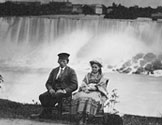

|
||||||||||||||||||||||||||||||||||||||
|
|
||||||||||||||||||||||||||||||||||||||
 |
 |
 |
 |
 Dance Hall Oddities Around the 1820s, the average worker could expect to be on the job twelve hours a day, six days per week. This sunrise to sunset schedule left precious little time to consider matters of leisure and amusement. Around 1836, the carpenters and masons of the time began to demand a ten-hour workday during the summer months. The local efforts of these craftsmen created the first labor unions in Niagara County. In time, all of the trades followed suit in this request for a shortened workday and the ten hour day became the legal standard by the mid 1800s.
Strange as it may seem, by shortening the workday from twelve to ten hours, this extra two hours of rest created quite an interest in amusements and avocations. Old newspapers of the time paint quite a picture of nighttime activities in Lockport and beyond. By 1840, Lockport sported some five or six “public halls” that sponsored an interesting array of activities. Boughton’s Hall, located on Canal Street was the first entertainment hall in the community. In Lockport’s infancy, several churches used the hall for their services until their congregations grew large enough to break away and build their own edifices. Additional advertisements for the hall described lectures on phrenology, whereby one’s character traits were purportedly explained by the shape of his skull. (A phrenology model is currently displayed in the Fitzgerald Medical Arts Room at the History Center in Lockport.) In later years, several parlors of entertainment filled the pages of the Daily Journal. Advertisements regarding Franklin Hall describe the appearance of a blind harpist and a 12-year-old “Giantess” weighing 330 pounds. The Erie Canal was responsible for bringing a huge array of traveling oddities into view of a wide-eyed populace. Such curiosities included the world’s largest woman at 800 pounds, the world’s smallest man at 19 years of age weighing 7 pounds, the Swiss Bearded Lady, and the Lilliputian King; described as five times smaller than Tom Thumb.
Douglas Farley, Director |
|